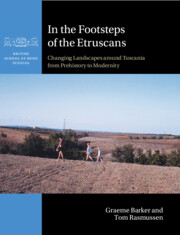Book contents
- In the Footsteps of the Etruscans
- British School at Rome Studies
- In the Footsteps of the Etruscans
- Copyright page
- Dedication
- Contents
- Figures
- Tables
- Contributors
- Preface and Acknowledgements
- 1 The Tuscania Archaeological Survey: Rationale, Aims and Objectives
- 2 Methodologies
- 3 The Natural Landscape and Its Evolution
- 4 Prehistoric Landscapes
- 5 Etruscan Urbanization, c. 700–300 bc
- 6 ‘Romanization’: The Roman Republican Period, c. 300–30 bc
- 7 The Roman Imperial and Late Antique Periods, c. 30 bc–c. ad 700
- 8 Incastellamento and Its Aftermath: Medieval and Modern Landscapes, c. ad 700 to the Present
- 9 A Mediterranean Landscape from Prehistory to Modernity
- Book part
- Bibliography
- Index
7 - The Roman Imperial and Late Antique Periods, c. 30 bc–c. ad 700
Published online by Cambridge University Press: 12 October 2023
- In the Footsteps of the Etruscans
- British School at Rome Studies
- In the Footsteps of the Etruscans
- Copyright page
- Dedication
- Contents
- Figures
- Tables
- Contributors
- Preface and Acknowledgements
- 1 The Tuscania Archaeological Survey: Rationale, Aims and Objectives
- 2 Methodologies
- 3 The Natural Landscape and Its Evolution
- 4 Prehistoric Landscapes
- 5 Etruscan Urbanization, c. 700–300 bc
- 6 ‘Romanization’: The Roman Republican Period, c. 300–30 bc
- 7 The Roman Imperial and Late Antique Periods, c. 30 bc–c. ad 700
- 8 Incastellamento and Its Aftermath: Medieval and Modern Landscapes, c. ad 700 to the Present
- 9 A Mediterranean Landscape from Prehistory to Modernity
- Book part
- Bibliography
- Index
Summary
The project’s results indicate that a landscape once dominated by small, family-run, farms, each cultivating small plots of land, gradually transformed through the three phases of the Roman imperial period (Early, 30 BC-AD 120: 205 sites; Mid, AD 120-260: 174 sites; Late, AD 260-440: 146 sites) into one featuring large agricultural estates involved in extensive farming practices. In light of historical records it seems likely that affluent investors bought up much of the land of failing smallholders, expanding the capacity of their own agricultural enterprises and leasing out properties to poorer farmers. Local wealth, power, and influence became concentrated in the hands of a limited number of elite landowners. Yet despite this process, small low-status sites remained the most abundant class of rural habitation even in the Late Imperial period and many middle-ranking sites endured without a break in occupation even into Late Antique times (AD 440-700: 77 sites in total). The resilience of wide sections of the rural community, even in the face of external threats from Longobards and others, should not be underestimated, but significantly a considerable proportion of Tuscania’s hinterland of cultivated fields had reverted to scrub and woodland by the Late Antique period.
Keywords
- Type
- Chapter
- Information
- In the Footsteps of the EtruscansChanging Landscapes around Tuscania from Prehistory to Modernity, pp. 214 - 245Publisher: Cambridge University PressPrint publication year: 2023



